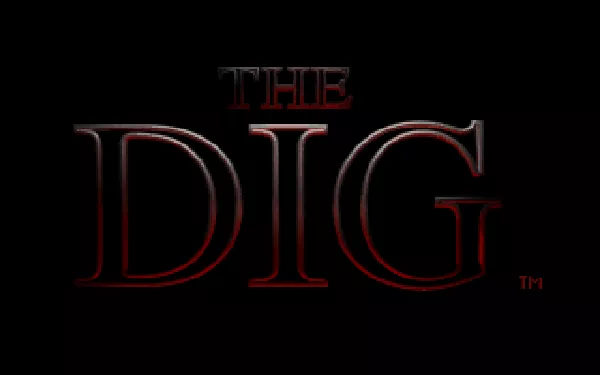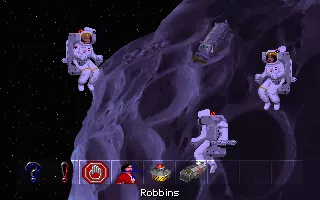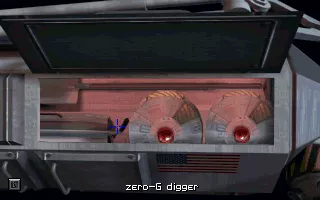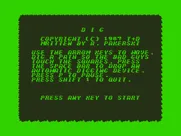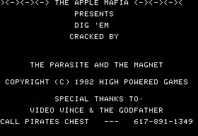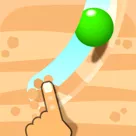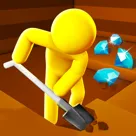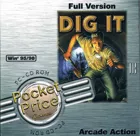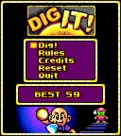The Dig
Description official descriptions
A group of scientists discovers an asteroid that is on its way to a collision with the Earth. Is there any way to prevent the disaster? Boston Low, a NASA veteran, is sent to command a space expedition on the asteroid. Accompanied by the journalist Maggie Robbins and the archaeologist Brink, Boston investigates the asteroid and finds a strange structure that undoubtedly belongs to an alien civilization. During the course of investigations, the team finds itself on a seemingly deserted planet. They have no knowledge of the planet and no possibility of going back. Will they ever discover the secret of this strange world and find a way to get home?
The Dig is a point-and-click adventure game with a simple one-cursor interface. Most of the puzzles are inventory-based, tending to be somewhat more complex than in most preceding LucasArts' adventure games. There are also a few logic-based puzzles, which require understanding and manipulation of alien technology and life forms on the planet. Traditional branching dialogue system is utilized; however, the game focuses more on puzzle-solving than on conversations to advance the plot.
The game's story is influenced by science fiction literature and movies, and strives to be realistic, departing from the comedy style of LucasArts' adventures. Despite that, humorous elements are present in some of the dialogues and text descriptions. The game utilizes hand-drawn graphics with a few pre-rendered 3D images.
Spellings
- 异星搜奇 - Simplified Chinese spelling
- 디그 - Korean spelling
Groups +
Screenshots
Promos
Credits (DOS version)
235 People (207 developers, 28 thanks) · View all
| Designed by | |
| Directed by | |
| Based on a Concept by | |
| Dialogue by | |
| Additional Story by | |
| Additional Additional Story by | |
| Art Style | |
| Creature Concept | |
| Lead Artist | |
| Background Art | |
| Supervising Animators | |
| Animators | |
| Special Effects Animators | |
| Additional Animation | |
| [ full credits ] | |
Reviews
Critics
Average score: 82% (based on 38 ratings)
Players
Average score: 3.9 out of 5 (based on 237 ratings with 21 reviews)
The Good
This came out at an odd time for Lucasarts - after 'The Secret of Monkey Island 2' had been criticised for being too easy, they released this and 'Full Throttle', two solid adventures that, whilst pleasant enough, seemed to add little to the genre, and were not particularly hard. 'The Dig' is less cartoony and more 'serious' than their other games - it's a pulpy sci-fi adventure with the voice of Robert Patrick, the evil Terminator from 'Terminator 2'. It scores highly in terms of presentation - the animated intro is highly professional, and there's a constant, impressive score ('Wagnerian' according to the box) too.
The Bad
The puzzles veer from being utterly, utterly obscure (a sequence in which you manipulate a hovering drone in order to reactivate a power plant), to dull 'try every object with every other object' fests. Furthermore, what appeared to be a bug in my version of the the game rendered it unfinishable. Nonetheless, it's typically competent, and even when it's being dull there's the music to listen to.
The Bottom Line
Decent, solid adventure that won't tax you for more than a few days. With Robert Patrick!
DOS · by Ashley Pomeroy (225) · 2000
The Good
The art design, while not breathtaking, was actually quite good. The early segments of the game set up some suspense and hinted at a great game ahead.
The Bad
While the early portion of the game set things up well (and "killed" off one of the most annoying characters) the middle and final segments of the game were a complete letdown. With a plot that seemed to have been hacked out of mediocre pulp SF films of the mid-50's, ridiculous dialogue, and characters that seemed to have been stereotyped from the same era as the plot. Oh, and the annoying character comes back as some sort of Undead Bavarian Lingust From Hell.
The puzzles were only average, and some of them were patently absurd and/or obtuse in the extreme. The turtle-thing skeleton puzzle comes to mind.
And I just wonder why so many writers and art directors seem to think that -any- dead civilization would have built with stone in a vaguely Egyptian style, regardless of technical advances. Like they were building their cities with prior knowledge that one day they would vanish and so they should design everything to look sufficiently "ruined". Sure, whatever.
The Bottom Line
If you really like adventure games of the SCUMM variety you might want to check it out. It's not so much a bad game, as a game that isn't a fraction of what it could have been. The story would have been excusable 50 years ago, but today it is just trite and insulting.
Well, ok, it is pretty bad.
DOS · by Patrick Mills (36) · 2000
A demo's worth a thousand words, it's cheaper too.
The Good
When I played the demo to this game my jaw dropped upon the ground as the game opened to the harsh realization of the shuttle crew's desertion upon an unknown planet in an another galaxy. I was compelled to continue exploring the area, clicking on anything that moved, learning about how the bizzaire situation was beginning to take a toll on the crew until all the suspense lead up to the death of a crew member. I was into the game so much I had to continue, and the next week I purchased the full version game.
I enjoyed the game's dated sci-fi storyline and much like the demo, the opening scene of the game containing the press conference then the eventual exploration of the asteriod, Atilla, kept me glued to the monitor as if I was watching a classic sci-fi movie on cable. The music and artwork are fantastic (considering the times) as it was the first time I saw good 3D rendered graphics on the PC which were very compatible with the musical score to bring out the emotion of the storyline and highlight the vast unknown of space.
The Bad
I'm afraid however once I passed the point in which my fellow crew member died from falling into a crevice the game began to get very boring as the music dragged on annoyingly and I had no idea on where to go as the puzzles were very annoying and absurd. Some puzzles were extremely stupid like the repairing of a magnifying glass in some orgy of laser that kept the planet working and sometimes the only way to advance in the game is to walk back to a place which is on the other side on the planet and very irritating. This had potential to be a great game but instead was a disappointment, I suggest LucasArts should have taken the budget from this game and made Full Throttle a bit longer. I heard Steven Spilberg orignally wanted this to concept to be a movie but it would have been to long and expensive... I reckon "The Dig: The Movie" would have taken a big nose dive. Maybe next time I'll read a review then make assumptions from an official demo.
The Bottom Line
Play the demo to this game and leave it at that.
DOS · by JPBLO (5) · 2000
Discussion
| Subject | By | Date |
|---|---|---|
| Messy credits | chirinea (47495) | Jun 16, 2007 |
| How did you like the voice acting in this game? | LepricahnsGold (142745) | Jun 8, 2007 |
Trivia
1001 Video Games
The Dig appears in the book 1001 Video Games You Must Play Before You Die by General Editor Tony Mott.
Alien and planet name
The planet and aliens are not given a name, however the credits refer to the "Cocytan leader".
In the novelization, Brink decides to name the planet "Cocytus" from Dante's Divine Comedy, Cocytus being the exterior circle of the Underworld and the only way out. The aliens thus are referred to as "Cocytans". However, these concepts are not taken into consideration in the game.
Development
The Dig is based on the original concept of Steven Spielberg who originally created the storyline to be an episode in his Amazing Stories tv series. It would have been too expensive to shoot, so Spielberg approached LucasArts in 1989 with an idea of making it a game. The game itself went through several re-writes at LucasArts, so only the main storyline and a couple of puzzles were carried out from Spielberg's original ideas.
The Dig went through three phases of development while in production, each with different project leaders.
The first phase was led by Noah Falstein. In this version, the game was set upon a jungle planet, very unlike the final version. One major part of this version apparently was that you had to collect and consume food and water to keep your character alive.
The second phase was led by Brian Moriarty. Moriarty tossed out all of the old art from the first version, as well as the "collecting resources" RPG-style elements.
In this version, there were four characters: Boston Low, Ludger Brink, Judith Robbins, and Toshi Olema, a Japanese physicist. As in the final game, this crew was transported to an alien planet via a ship disguised as an asteroid.
This version was controlled via a standard LucasArts-style interface at the bottom of the screen containing visual icons for the functions Examine, Pick up, Use, Move, and Talk, as well as inventory items. Strangely, the game was not programmed in LucasArts' standard SCUMM engine, but instead something called StoryDroid Development System.
After a long series of internal conflicts, Brian Moriarty left the company and Sean Clark took over the project. Clark was the one who actually got the game finished. He changed Judith's name to Maggie and removed Toshi Olema from the plot.
In early betas of Sean Clark's version, the characters looked the same as they did in Brian Moriarty's version (with Low and Robbins both having blond hair). These sprites were later changed and made more visually striking.
In addition, though early betas of this new version used an interface at the bottom of the screen with the same icons for interaction as in Moriarty's game, this was later rejected for the final "one-click-does-it-all" interface which the public saw.
Also, the voices in the final game were not the same as those heard in early betas of Clark's The Dig. Those unused voices lasted long enough to be present in the official demo of The Dig.
Extras
Some copies of The Dig came with a free copy of the Trade Paperback version of Alan Dean Foster's game novelization (a $12.95 value according to the box sticker).
Novel
Although there's no movie based on it, there is a book based on the game, also called The Dig, written by science fiction writer Alan Dean Foster.
References
- Main character Boston Low is voiced by Robert Patrick, who incarnated the evil liquid terminator in the movie Terminator 2. At one point in the game, Boston shows Maggie a photo of lost comrade Brink, and asks her "Have you seen this boy?", paraphrasing the evil terminator's trademark question in that popular movie. Also, when the player looks at his PenUltimate he's gonna say that it's the "T-1000 Model".
- According to the game's demo, the ship that carries out the Attila mission in the first part of the game is Space Shuttle Atlantis. However this reference was cut from the final game.
Shapes
Take a look at the PenUltimate communicator and you will notice that there is a geometric shape on it. It is what the plates inside Atilla look like when they are put together.
Soundtrack
Even though Michael Land's score for the game was released on CD (albeit in a very low amount), it suffered from the worst 'disease' of all official soundtracks, painfully well known to collectors of film scores - it was cut, and not all the music appearing in the game was included. However, the tracks can be extracted with external utilities. Details can be found in the tips & tricks section.
Title
After finishing the game, you might start to wonder if the game's title is in any way connected to the over-usage of the shovel item in the game (main character digs holes every now and then, and rather often), because there is definitely no dig site to explore (not assuming half-blasted asteroid).
Awards
- Computer Gaming World
- November 1996 (15th anniversary issue) – #3 Top Vaporware Title in Computer Game History
Information also contributed by ATMachine, Boston Low, ClydeFrog, Daniel Albu, Dirk Struan, G J, Jaromir Krol, MAT, Swordmaster and Trixter
Analytics
Upgrade to MobyPro to view research rankings!
Related Sites +
-
GJ's Dig Site
Character profiles, images including ads, screenshots, backgrounds, etc, humour. -
Hints for The Dig
These won't spoil the game, but will give you just what you need to solve the game. Final solutions are included. -
ScummVM
Get "The Dig", as well as many other adventure games, to run on modern systems by using ScummVM, a legal and free program. -
The Dig - FAQs & Guides
Several walkthroughs and other files on GameFaqs.com -
The Dig Museum
Includes interviews with creators, creation information, and "Ask Yoda" section. -
The Dig Soundtrack
Music from the game -
The Dig Walkthrough
Start to finish solution for The Dig
Identifiers +
Contribute
Are you familiar with this game? Help document and preserve this entry in video game history! If your contribution is approved, you will earn points and be credited as a contributor.
Contributors to this Entry
Game added by robotriot.
Linux added by click here to win an iPhone9SSSS. Antstream added by lights out party. Windows added by MAT. Macintosh added by Jason Savage.
Additional contributors: Mickey Gabel, Unicorn Lynx, Jeanne, Apogee IV, G J, CubbyKatz, CaesarZX, Picard, Patrick Bregger, FatherJack.
Game added November 1, 1999. Last modified April 12, 2024.





